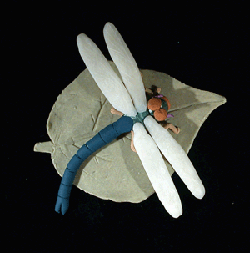Dragonfly Anatomy Lesson:
Dragonfly Magnet or Pin
 Objective:
Students will build an anatomically correct dragonfly of polymer clay
while using vocabulary for body parts learned while studying dragonfly
anatomy. Older students will also define the function of the body parts
as adaptations for survival.
Objective:
Students will build an anatomically correct dragonfly of polymer clay
while using vocabulary for body parts learned while studying dragonfly
anatomy. Older students will also define the function of the body parts
as adaptations for survival.
Grade Levels:
Grade K-6
Time Required: One class period
Image: four-inch square
polymer clay dragonfly
Materials:
- images of dragonflies from ISM web site and other sites or sources
- Sculpey™ polymer clay (it is softer than Fimo™ brand) in
various colors, including -transparent polymer clay dragonfly magnet
(Fimo Brand Transparent #00) for wings.
- paper to use on the tabletop (protection and rolling surface)
- plastic knife or age-appropriate blade to cut
- dedicated pizza pan on which to bake finished sculpture
- E6500 glue
- magnet pieces or pinbacks
Vocabulary:
head, thorax, abdomen, jointed legs, wings, compound eyes, jaws, segments,
terminal appendages
Motivation:
Dragonfly body parts have specific names and shapes. Each part helps
the dragonfly to survive in its environment.
1. What are these body parts?
2. How do they look?
3. Where are they located?
4. How do they relate to each other in size and function?
5. What are these body parts used for?
6. Could the dragonfly live without any of them?
7. How do these parts help the dragonfly survive?
Procedure:
- Open the packages of various colors of Sculpey© polymer clay.
The Internet and books on polymer clay will have detailed insturctions
on how to work with this material. Follow all safety instructions.
- Cut the blocks into 4-8 pieces each. Arrange the colored pieces on
the table for students to choose. They will need varying amounts of
each color. They can choose realistic colors that look like some for
the species studied, or they can choose their own colors (being aware
they are not found in nature.) Some colors are adaptations that help
the dragonfly survive.
- Briefly condition the clay by rolling the little blocks in the hands
to soften and form into a ball.
- Pinch off amounts of clay and start forming body parts of your dragonfly.
You may want to form the segmented abdomen somewhat thicker than in
nature to avoid breakage. Alternatively, the dragonfly can be sitting
on a separately modeled background leaf to solve this problem.
- Combine the body parts by firmly pressing the parts together without
smashing or deforming them. If clay gets too soft with handling, laying
it aside for ten minutes will allow it to firm up.
- Bake clay in 250-degree oven for about ½ hour. (Oven will need to be
cleaned with baking soda solution after baking, or use an oven not used
for food preparation.) Toaster ovens are okay if they will not burn
with their upper coils - This will cause toxic fumes.
- Glue pin backs or magnets to the back of the dragonflies after they
have cooled. E6500 glue needs to cure overnight.
Assessment:
Students will identify and define all body parts they created on their
dragonflies. Older students will state how the body parts are adapted
for survival in the dragonfly habitat.
Illinois State
Board of Education Goals Addressed:
Science: Early Elementary:
12.A.1a:
Identify and describe the component parts of living things (e.g.,
birds have feathers; people have bones, blood, hair, skin) and their
major functions.
12.A.1: Categorize living organisms using a variety of observable
features (e.g., size, color, shape, backbone).

